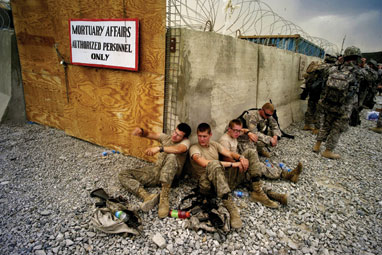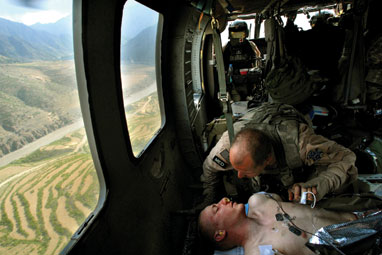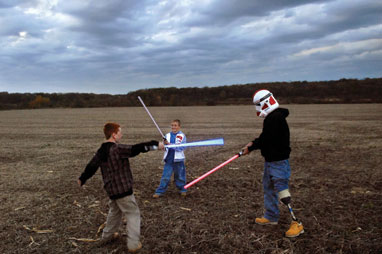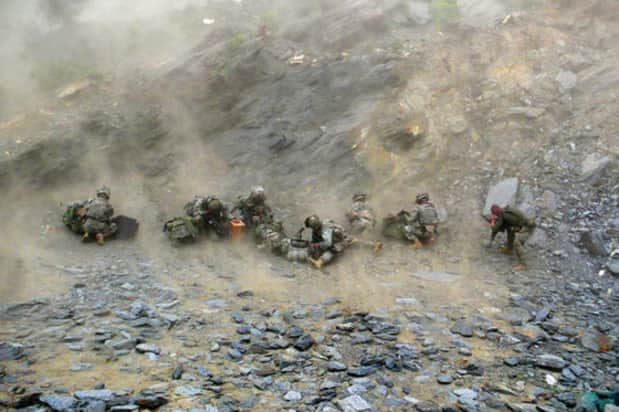In our current photo issue, we feature some of our photographers' most personal work: Peter van Agtmael has been documenting American soldiers, both in Iraq and Afghanistan and as they return home, since 2006. View the slideshow from the American Wars photo essay, with commentary by one of his subjects, Iraq veteran Raymond Hubbard. After the jump, read Julianne Shepherd's accompanying story from FADER Number 57.
At the dawn of the Iraq war, when newspapers still published daily front-page dispatches from the warfront, the American public only received a limited picture of the troops’ lives in Iraq and Afghanistan. Since the military conflicts began, our idea of its scope has largely been pieced together from the visuals: videos YouTubed by soldiers. Torture snapshots from Abu Ghraib. Photocopied memorials for neighborhood soldiers killed in combat, posted in local restaurant windows. Maybe we try to imagine it via Generation Kill. Even if we know someone stationed there, rarely do we witness a wholly humanistic view of what’s going down every moment in America’s seemingly endless military actions abroad.
Peter van Agtmael’s images are a revelatory exception. Embedded in Iraq and Afghanistan consistently since January of 2006, he first lived with and photographed the sole US unit patrolling the violent Northern Iraqi town of Mosul. The 27-year-old photojournalist captures the generally unseen day-to-day of the troops and residents—humanistic images that reveal the emotion within the countries’ quiet, practically mundane stolen moments and within its nightmarish chaos. No matter the context, the photographs are bound by the anguish, exhaustion, fear and, occasionally, joy on the subjects’ faces.

Van Agtmael set out to personalize his photographs as much as possible, a noble mission that naturally engendered close friendships, so that not only was he capturing their stories, he was inextricably tangled in their lives, following them from deployment to discharge. In September of 2007, van Agtmael met Raymond Hubbard of Darien, Wisconsin, who is depicted playing Star Wars with his children in this essay. Hubbard lost his leg on July 4, 2006 after a rocket landed near a tower he was manning on guard duty. “It sent shrapnel into his body, severed his left leg immediately, severed an artery in his neck, so he was just pumping out blood. By the grace of god, there were ambulances just up the hill, so he got medical treatment very quickly, otherwise he would have bled out,” van Agtmael says. “He lost so much blood he suffered a stroke and was in a coma for a month.” The circumstances surrounding his injury were identical to the way his father was injured in Vietnam, leading to a sort of familial redemption story for Hubbard: his father was so emotionally and physically scarred from his experience, he drank himself to death by the time Hubbard was fifteen. But the younger Hubbard, despite his own injuries, has been blessed with a more optimistic future. “He got a prosthetic leg and his wife has stuck with him through thick and thin,” says Van Agtmael. “His family held a fundraiser for him and the community raised over $30,000, no strings attached. He renovated his house, his kids started doing better in school because they wanted him to be proud of them, and he got one hundred percent disability from the army. So he’s got all these weirdly mixed feelings towards his injury. On one hand it messed him up, he hasn’t regained full cognitive functionality, he’s in a lot of pain. But on the flipside, somehow the struggle to survive has made him more content and happy. And he is no longer afraid of repeating his father’s mistakes.”
How does one deal with living a better life after losing a leg? How do troops balance their sense of duty with their sense of what is right? How do citizens at home reconcile a disdain for the war with support for the soldiers? It is impossible to face the military actions in Iraq and Afghanistan without getting mired in some kind of moral dilemma. While van Agtmael’s photographs personalize the individual in a rare and eloquent way, they also tell his own tale: of the transformation one endures from endless days of war, and of the ethical issues a relatively young man who is voluntarily embedded must confront.

“Being aware of what could happen to me in Iraq helped a lot in terms of getting through some of the worst moments,” he says. “This is getting into an emotional question. I’ve seen a lot of people die and I myself have had my own existence threatened on multiple occasions. That changes you profoundly. But of course you can’t register that change because it happens in a split second. It takes a long time after that to figure out what that means and how to overcome it so you can live a better life.”
After a year and a half in various embeds, Van Agtmael was, he says, “burned out,” so he flew back to the States and temporarily switched his focus to photographing troops domestically. He followed soldiers he had befriended in the Middle East as they returned to America and began piecing together their lives. “Doing those stories was a reflection upon how I was feeling. I had come out thus far without a scratch on me, but other people that were around me weren’t so lucky,” he says. Van Agtmael had photographed Lt. Matthew Ferrara as he took command of an outpost in Afghanistan’s Waigul Valley in 2007. After Ferrara was killed in an ambush by the Taliban, van Agtmael delivered his pictures to Ferrara’s family at his funeral and included them in some of his domestic work. “It seemed to me crucial, now that I’ve photographed these soldiers, sometimes taken a lot of photographs of them, who later ended up dying.” says van Agtmael. “They were almost ghosts. To be able to put it into a context that is familiar in America—photographing people like mothers, fathers, brothers, something everyone can relate to—I think that has the capacity to move people. In an ideal world. Of course, in the real world, they just don’t get published.”
Van Agtmael is a Magnum-represented photojournalist who has published in most major mainstream newsmedia, but the bulk of his work has never been printed outside of his website. Meanwhile the US Military has been increasingly stringent about its censorship. This past June, the Marine Corps permanently banned the photographer Zoriah Miller from further embeds after he published a photo of three (unidentifiable) Marines killed by a suicide bombing on his website. Worse, stories abound among photographers of editorial edicts at major newsmedia to publish the least controversial images, with top-level editors engaging in willful self-censorship. The inaccessibility of these photographs creates a dangerous subjectivity, a chasm between reality and how we are able to interpret and perceive the wars.

For van Agtmael, this is where his own moral dilemma comes into play. His sense of duty to document truth is complicated by the knowledge that, though he is threatened alongside the troops, he can leave whenever he pleases—yet his style has favored him with soldiers. “I’ve always gone in with the approach of doing a diary of my experiences. I shoot straightforward, with a very simple manner,” he says. “They’ve embraced it because there are complaints that other reporters bias their coverage on ‘the grand mission;’ behind it is this feeling among soldiers of being totally fucking forgotten. Most never come across journalists when they’re there, and most of them go through these intense events with total anonymity. I think that’s the power of the picture: these events would mean nothing to anyone, would just be a number or statistic, but they last forever with a picture. It’s just a shred of the experience of the pain and the emotion, but it’s evidence.”
Early in 2008, the US Army released the new statistic that every day, five US soldiers try to kill themselves, at the rate of seventeen-point-five percent per one hundred thousand soldiers. In February, Virginia Senator Jim Webb introduced the Armed Forces Suicide Prevention Act, mandating an outreach counseling program and enhancing the military’s suicide prevention programs. It was referred to the House Subcommittee on Military Personnel on February 11, 2008, but as of press time, it has not yet moved or been voted on. “I come from a family and friend environment of sensitive people who want to know how I’m doing and feeling and whether I need help,” says Van Agtmael. “But if you’re a soldier and you go to Iraq for a year, there’s little to no impetus in the military to get counseling for the fucked up things you did when you were nineteen years old. Then, because there are so few troops there, after you get home you go back for another year, and then home and back. There are a lot of guys who are in their third and fourth tours now. It’s not unusual, even if you sign up for like standard enlistment of like four or five years. No matter how loyal or patriotic you are, you don’t want to do two or three tours to Iraq or Afghanistan.”
Van Agtmael’s next project is photographing development in Africa, in tandem with Lt. Erik Malmstrom, whom he befriended on his first trip to Afghanistan. He will return to Iraq in 2009.
